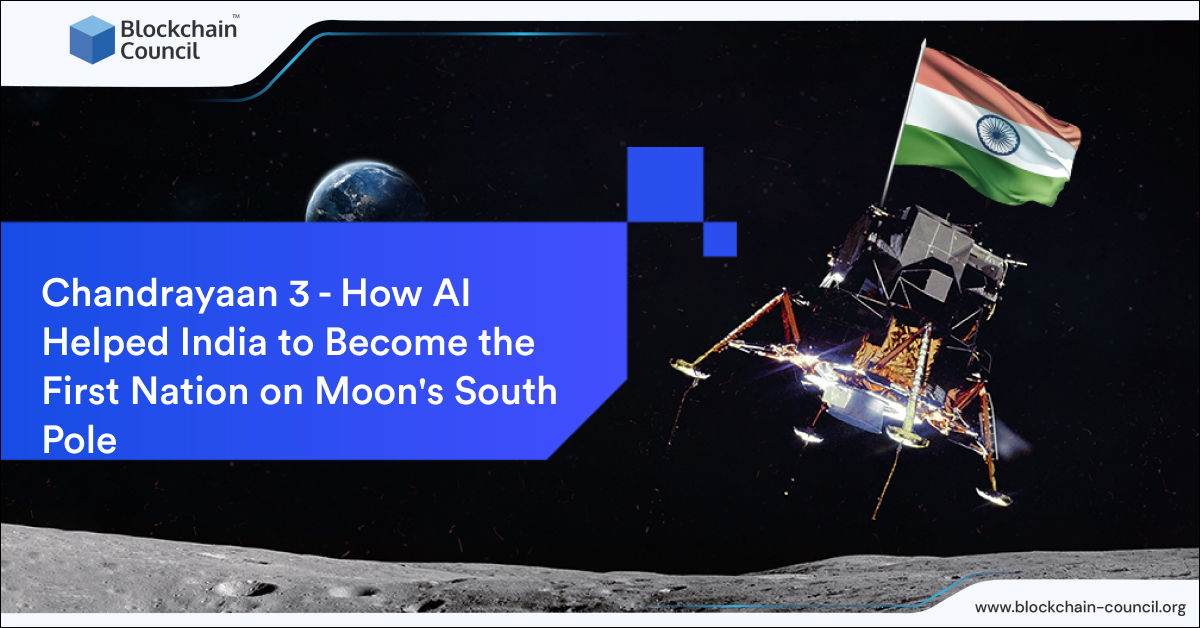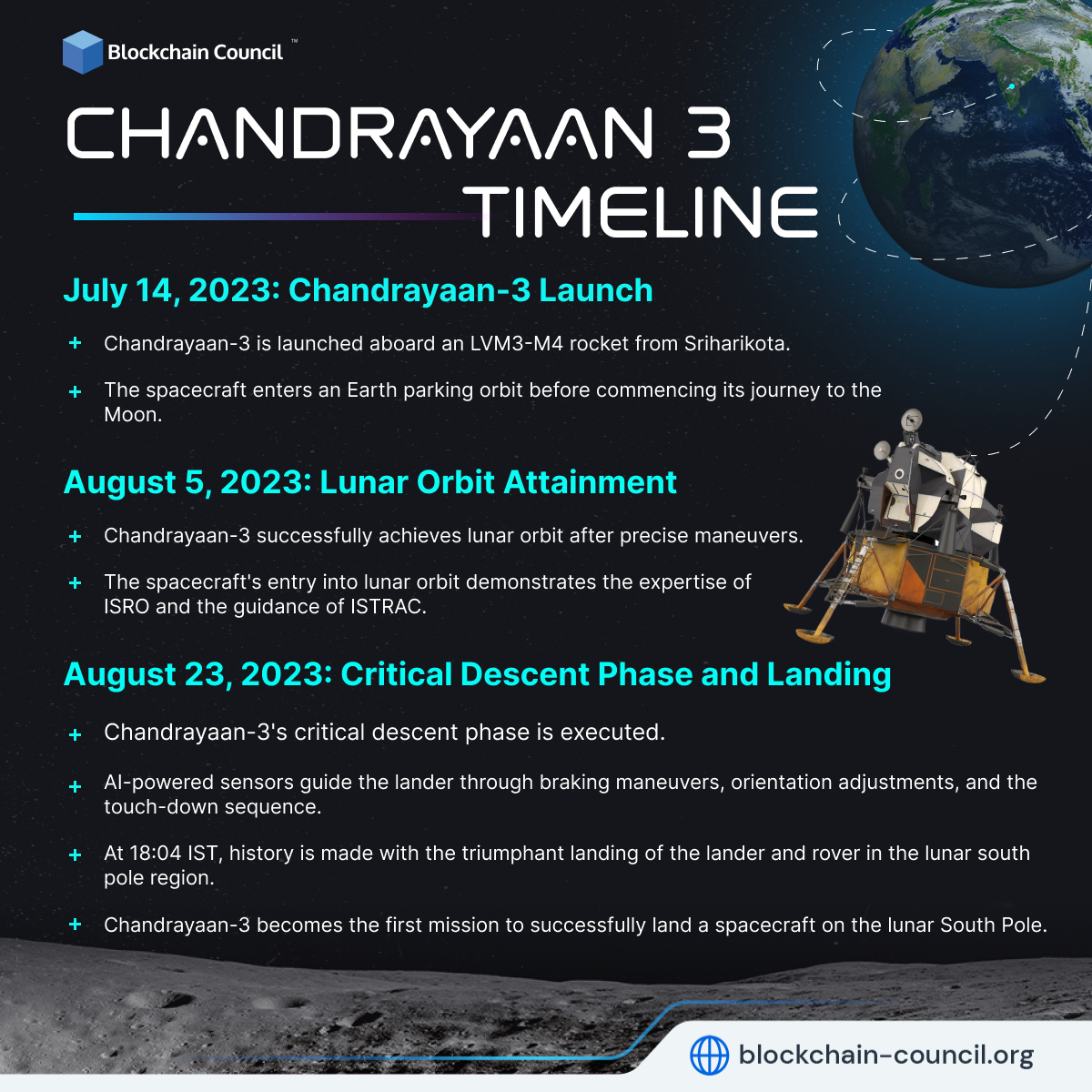
- Blockchain Council
- August 25, 2023
Summary:
- Chandrayaan-3 is India's third mission in the Chandrayaan program, launched by ISRO for lunar exploration.
- The mission's goal was to successfully land a spacecraft on the lunar South Pole, which it achieved on August 23, 2023.
- Chandrayaan-3 emerged after the Chandrayaan-2 mission faced landing failure due to a deviation during descent.
- Artificial Intelligence (AI) played a crucial role in Chandrayaan-3's success by guiding the spacecraft's complexities and ensuring a safe landing.
- Collaboration with the European Space Tracking Network (ESTRACK) added to the mission's success by sharing expertise.
- AI-powered sensors like velocimeters, altimeters, and accelerometers enabled precision landing by mapping lunar topography and recalibrating the descent trajectory.
- Chandrayaan-3 consisted of three main components: Propulsion Module, Lander (Vikram), and Rover (Pragyan).
- AI-controlled descent allowed for better attitude and thrust control, reducing landing failure risks.
- Enhanced AI-driven attitude correction rate and redesigned impact legs contributed to improved landing accuracy.
- Chandrayaan-3's AI-calculated landing region was more accurate, aided by images from Chandrayaan-2's orbiter.
- AI-powered instruments on the lander and rover analyzed lunar surface data: thermophysical experiment, seismic activity measurement, plasma density estimation, chemical and mineralogical composition analysis, and elemental composition analysis.
- The transition from horizontal to vertical orientation during descent was supervised by AI through the Lander Horizontal Velocity Camera (LHVC).
- Chandrayaan-3 followed a well-choreographed sequence of events: launch, orbit attainment, and critical descent phase.
- AI's calculations and decisions were integral to Vikram's descent, adapting to real-time lunar variables.
- Chandrayaan-3's success represents India's technological advancement and determination in space exploration.
- The mission's accomplishment signifies the synergy between human ingenuity and machine intelligence.
- The data collected and insights gained from Chandrayaan-3 will contribute to a deeper understanding of the Moon and space exploration.
- This success reflects humanity's continuous progress in space exploration and innovation.
In the realm of space exploration, India has etched its mark once again with Chandrayaan-3, the third endeavor under the Indian Space Research Organisation’s (ISRO) Chandrayaan program. This mission, propelled by technological innovation and guided by the precision of artificial intelligence, catapulted India to a historic milestone – becoming the first nation to successfully land a spacecraft on the lunar South Pole.
But do you know how artificial intelligence helped India create history? In this article, we look back at the undeniable contributions of artificial intelligence in the Chandrayaan-3 mission.
A Brief Overview of Chandrayaan-3
The saga commenced on July 14, 2023, when Chandrayaan-3 embarked on its cosmic journey. Anticipation rippled as it soared, with eyes set on the Moon’s mysterious south pole. On August 23, 2023, at 18:04 IST, history was etched – the triumphant touchdown of the lander and rover in the lunar south pole region.
Yet, this triumph was hard-won, with Chandrayaan-2 as a poignant precursor. Launched in July 2019, it carried an orbiter, lander, and rover. However, its lander encountered a heartbreaking deviation during descent. Undeterred, Chandrayaan-3 emerged, a symbol of resilience and determination, focused on conquering the lunar south pole.
Underneath this triumph lies AI’s unsung role. Guiding the spacecraft with precision, AI navigated complexities and ensured a secure landing. This silent force epitomized data-driven decision-making at its finest.
Collaboration also fueled Chandrayaan-3. The European Space Tracking Network (ESTRACK), operated by the European Space Agency (ESA), stood in solidarity. This partnership signifies a new age of shared expertise, amplifying space exploration’s reach.
The Synergy of AI and Spacecraft Design
At the heart of Chandrayaan-3’s triumphant lunar landing lies a sophisticated array of AI-powered sensors, a testament to modern technological marvels. These sensors encompass velocimeters, altimeters, and accelerometers that orchestrate the precision-driven landing with unparalleled accuracy. Unlike earlier lunar missions that grappled with landing deviations, Chandrayaan-3’s sensors harnessed AI’s capabilities. Armed with data from these sensors, AI models meticulously mapped the lunar topography, identified potential hazards, and recalibrated the descent trajectory to ensure a meticulously controlled landing.
Chandrayaan-3, a product of meticulous engineering, consisted of three main components, each meticulously designed to contribute to its mission:
- Propulsion Module: This module carried the lander and rover configuration into a lunar orbit of 100 kilometers. Equipped with a sizeable solar panel and a cylindrical mounting structure for the lander, this module served as the precursor to the crucial landing phase.
- Lander (Vikram): Responsible for the soft landing on the Moon’s surface, Vikram was a box-shaped marvel with four landing legs and four landing thrusters. These thrusters boasted an impressive thrust of 800 newtons each, aiding the precision landing. Unlike its predecessor, Chandrayaan-2, Vikram’s design featured four variable-thrust engines with improved attitude control and rate, maximizing its ability to navigate the descent phase.
- Rover (Pragyan): Pragyan, the six-wheeled rover with a weight of 26 kilograms, was equipped with a variety of instruments to analyze the lunar surface. With dimensions of 917 mm x 750 mm x 397 mm, this compact rover was geared to conduct in-depth research on the lunar composition, history of impacts, and more.
Certified Chatbot Expert™
The AI Revolution in Lunar Descent
At the heart of Chandrayaan-3’s triumphant lunar landing lies a sophisticated array of AI-powered sensors, a testament to modern technological marvels. These sensors encompass velocimeters, altimeters, and accelerometers that orchestrate the precision-driven landing with unparalleled accuracy. Unlike earlier lunar missions that grappled with landing deviations, Chandrayaan-3’s sensors harnessed AI’s capabilities. Armed with data from these sensors, AI models meticulously mapped the lunar topography, identified potential hazards, and recalibrated the descent trajectory to ensure a meticulously controlled landing.
Chandrayaan-3’s lunar descent, considered one of the most intricate phases of space missions, was meticulously guided by AI algorithms. Here’s how AI played a transformative role:
- Orientation and Thrust Control: Unlike Chandrayaan-2, where the fifth centrally-mounted thrust engine contributed to landing failure, Chandrayaan-3’s AI-controlled descent allowed for attitude and thrust control during all descent phases. The addition of a Laser Doppler Velocimeter (LDV) enabled the precise measurement of attitude in three directions.
- Increased Attitude Correction Rate: Chandrayaan-3’s AI-driven attitude correction rate surged from 10°/s (Chandrayaan-2) to 25°/s. This upgrade facilitated swifter adjustments during descent, enhancing landing accuracy.
- Redesigned Impact Legs and Redundancy: Chandrayaan-3’s lander was equipped with stronger impact legs and improved instrumentation redundancy compared to its predecessor. These enhancements, combined with increased structural rigidity, data frequency, and transmission, bolstered the lander’s survivability during potential descent and landing failures.
- Precise Landing Region Targeting: By utilizing images from Chandrayaan-2’s orbiter’s High-Resolution Camera (OHRC), Chandrayaan-3’s AI calculated a more accurate landing region of 4 km x 4 km.
AI-Powered Scientific Payloads
Chandrayaan-3’s scientific payload, divided between the lander and rover, encompassed cutting-edge instruments that relied on AI for data analysis:
Lander Payloads:
- Chandra’s Surface Thermophysical Experiment (ChaSTE): This instrument measured the lunar surface’s thermal conductivity and temperature.
- Instrument for Lunar Seismic Activity (ILSA): Designed to measure seismic activity around the landing site.
- Langmuir Probe (LP): Estimated near-surface plasma density over time.
Rover Payloads:
- Alpha Particle X-Ray Spectrometer (APXS): Determined the chemical and mineralogical composition of lunar soil.
- Laser-Induced Breakdown Spectroscope (LIBS): Analyzed elemental composition of lunar soil and rocks.
Propulsion Module Payloads:
- Spectro-polarimetry of Habitable Planet Earth (SHAPE): Studied Earth’s spectral and polarimetric measurements from lunar orbit.
Become a Certified Artificial Intelligence (AI) Expert™
The Flight Path and Landing
A pivotal juncture during the descent is the transition from horizontal to vertical orientation. Drawing lessons from the challenges of the Chandrayaan-2 mission, ISRO leveraged AI as a safety net. The AI system honed through exhaustive simulations, supervised this orientation shift. The Lander Horizontal Velocity Camera (LHVC), under AI’s guidance, adeptly tilted the lander to a precise 90-degree angle. This episode underscores the intricate dance of human intellect and AI-enabled automation.
Chandrayaan-3’s mission profile was a meticulously choreographed sequence of events:
Conclusion
At the core of this success is artificial intelligence. It’s not a passive element but a guiding force. AI’s calculations and decisions orchestrated Vikram’s descent, adapting to real-time lunar variables. This mission’s achievement isn’t just in its landing; it’s in the seamless interaction between human ingenuity and machine intelligence.
Chandrayaan-3 marks not an end but a new beginning. Data collected, images sent – these are fragments of a larger mosaic. The lunar surface beneath Vikram and Pragyan holds secrets waiting to be unraveled, insights that could reshape our understanding of the Moon and beyond.
Chandrayaan-3’s success echoes through time and space. It’s a testament to India’s technological strides and unyielding determination. As we look to the future, we’re reminded that in the vast expanse of the cosmos, human innovation knows no bounds. With each mission, each landing, humanity takes another step toward the stars.
Frequently Asked Questions
- AI-guided spacecraft with precision for secure lunar landing.
- AI models analyzed data from sensors, mapped lunar topography, and adjusted descent trajectory.
- AI algorithms controlled attitude, thrust, and orientation during descent, enhancing accuracy.
- Redesigned impact legs and redundancy in the lander bolstered survivability during failures.
- AI algorithms guided orientation and thrust control throughout the descent phases.
- Laser Doppler Velocimeter enabled precise attitude measurements.
- The attitude correction rate increased to 25°/s, enhancing landing accuracy.
- AI calculated an accurate landing region using Chandrayaan-2 orbiter images.
- Lander payloads included instruments for measuring thermal conductivity, seismic activity, and plasma density.
- Rover payloads included tools to analyze the chemical and mineral composition of lunar soil and rocks.
- The propulsion module carried an instrument studying Earth’s spectral measurements from lunar orbit.
- The AI system supervised the orientation shift, drawing lessons from Chandrayaan-2 challenges.
- The Lander Horizontal Velocity Camera (LHVC) tilted the lander to a precise 90-degree angle with AI guidance.
- Launched on July 14, 2023, aboard LVM3-M4 rocket from Sriharikota.
- Achieved lunar orbit on August 5, 2023, after precise maneuvers.
- Executed critical descent phase on August 23, 2023, with AI-powered sensors guiding the lander through braking, orientation changes, and touch-down sequence.






































































 Guides
Guides News
News Blockchain
Blockchain Cryptocurrency
& Digital Assets
Cryptocurrency
& Digital Assets Web3
Web3 Metaverse & NFTs
Metaverse & NFTs
